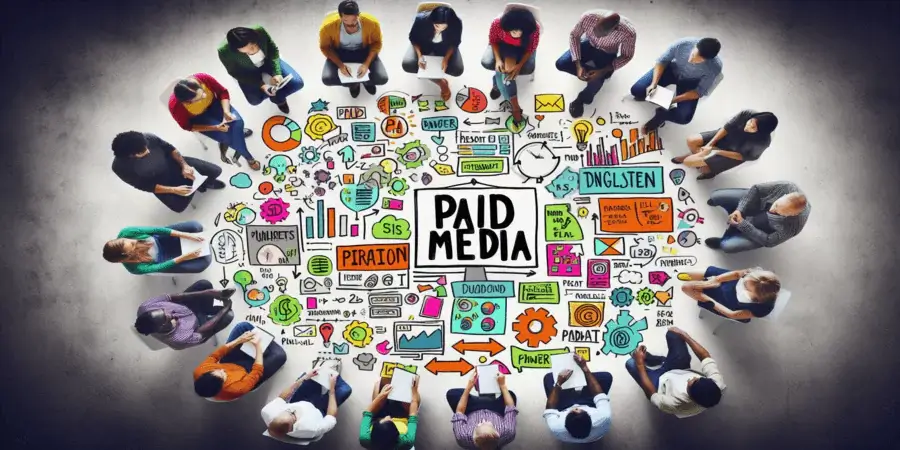In the modern marketing landscape, paid media is a key strategy used by businesses to boost visibility, drive engagement, and achieve marketing goals. Unlike owned media, which is controlled directly by the brand, and earned media, which comes from external endorsements, paid media involves paying for promotional space to reach a broader audience. This article explores the definition of paid media, its benefits, and offers real-world examples to illustrate its effectiveness.
Definition of Paid Media
Paid media refers to any form of advertising where a business pays to promote its content, products, or services. It includes various channels and formats where companies invest financial resources to gain exposure and drive specific actions from their target audience. Paid media encompasses:
- Display Ads: Banner and video ads placed on websites and apps.
- Search Engine Advertising: Paid ads appearing on search engine results pages (SERPs) through platforms like Google Ads.
- Social Media Advertising: Sponsored posts, stories, and ads on social media platforms such as Facebook, Instagram, LinkedIn, and Twitter.
- Native Advertising: Ads that blend seamlessly with the content of a website or app, appearing as editorial content.
- Influencer Partnerships: Payments to influencers for promoting products or services to their followers.
- Paid Partnerships and Sponsorships: Collaborations with media outlets, events, or other brands involving financial exchange for promotional opportunities.
Paid media allows brands to target specific audiences, control ad placement and format, and measure campaign effectiveness.
Benefits of Paid Media
Paid media offers numerous advantages that can significantly enhance a brand’s marketing strategy:
- Increased Reach:
- Paid media expands visibility quickly. Investing in paid advertising helps businesses reach a larger audience, including new potential customers, making it valuable for broadening demographic reach or entering new markets.
- Targeted Advertising:
- Precision targeting is a major benefit of paid media. Ads can be tailored based on demographics, interests, behaviors, and location. For example, Facebook Ads enable targeting by age, gender, interests, and even purchase history, ensuring ads reach the most relevant individuals.
- Immediate Results:
- Unlike organic methods, which take time to build momentum, paid media delivers immediate results. Ads start appearing to the target audience right away, leading to quick increases in website traffic, leads, and sales.
- Enhanced Brand Visibility:
- Paid media improves brand visibility by placing ads in high-traffic areas where users are likely to see them. Whether through search engine results, social media feeds, or display networks, paid media ensures extensive exposure.
- Measurable Performance:
- Paid media campaigns are highly measurable. Businesses can track key performance indicators (KPIs) such as click-through rates (CTR), conversion rates, return on ad spend (ROAS), and more. This data helps in assessing campaign effectiveness and optimizing future strategies.
- Flexibility and Scalability:
- Paid media offers flexibility in budgeting and campaign scale. Businesses can start with a small budget and scale up based on performance. Campaigns can be adjusted as needed, allowing for responsive strategies based on market conditions and business goals.
Examples of Paid Media
Here are real-world examples illustrating the impact of paid media:
- Search Engine Advertising:
- Google Ads exemplifies search engine advertising. When a user searches for terms related to a business’s products or services, paid ads appear prominently on search results pages. For instance, searching for “best running shoes” might display ads from Nike or Adidas, driving traffic to their websites.
- Social Media Advertising:
- Platforms like Instagram offer robust advertising options. For example, a fashion brand might use Instagram Ads to showcase new collections, targeting users interested in fashion and shopping with visually appealing ads.
- Display Advertising:
- Display ads appear on websites and apps. For instance, a user visiting a news site might see banner ads promoting a new software product or event, designed to capture attention and drive user action.
- Native Advertising:
- Native ads blend with website or app content. Sponsored articles on news sites, which look like regular content but are paid placements, provide value to readers while promoting the brand’s message.
- Influencer Partnerships:
- Influencer marketing involves paying influencers to promote products or services. For example, a beauty brand might collaborate with a popular beauty influencer to review and showcase a new skincare line, reaching the influencer’s dedicated audience.
Strategies for Effective Paid Media
To maximize the effectiveness of paid media, consider the following strategies:
- Define Clear Objectives: Set clear goals for your campaigns, such as increasing brand awareness, generating leads, or driving sales.
- Target Your Audience: Utilize advanced targeting options to ensure ads reach the right audience based on demographics, interests, and behaviors.
- Create Compelling Ads: Design engaging and visually appealing ads with strong calls-to-action (CTAs) to capture attention and encourage user interaction.
- Monitor and Optimize: Regularly track campaign performance and use data to make informed adjustments. Optimize campaigns based on metrics like CTR, conversion rates, and ROAS.
- Test and Iterate: Conduct A/B testing to compare different ad variations and refine your approach based on performance insights.
Conclusion
Paid media is a crucial component of a successful marketing strategy, offering increased reach, targeted advertising, immediate results, and measurable performance. By understanding its definition, benefits, and real-world examples, businesses can effectively leverage paid media to achieve marketing objectives and drive significant results. Through strategic planning, creative execution, and ongoing optimization, paid media can enhance brand visibility and drive growth in today’s competitive landscape.





